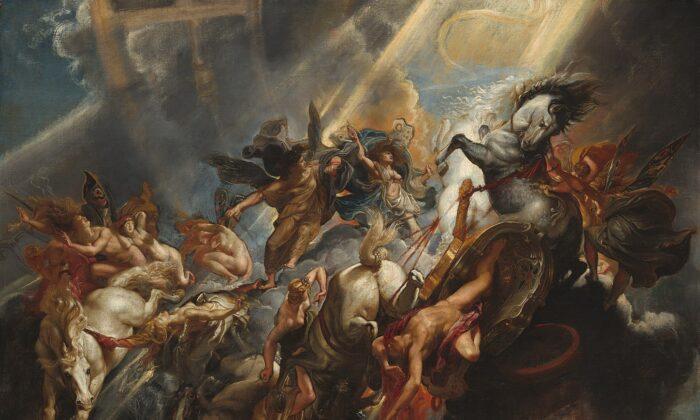In my social media feeds, I often see Picasso’s famous quotes: “Every child is an artist. The problem is how to remain an artist once we grow up,” or “It took me four years to paint like Raphael but a lifetime to paint like a child.” Is Picasso right? Is art that tries to embody a child’s mindset good for our culture?
Mythological tales have historically been intertwined with cultural teachings. Sharing myths was a way of continuing and strengthening the spiritual and moral aspects of a culture. In my pursuit to see if there were any images of myths that suggest the effect of a child’s perspective on culture, I came across this image by Flemish artist Peter Paul Rubens titled “The Fall of Phaeton.”
The story of Phaeton is as follows: A water nymph, Clymene, and the sun god, Helios, have a child named Phaeton. When Phaeton was a young boy, he was teased and his legitimacy was challenged by his playmates. Clymene told Phaeton to ask his father for guidance, and the boy asked his father to help prove his legitimacy. Helios agreed to give Phaeton anything to help.
Unfortunately, Phaeton requested to drive the sun chariot for a day. Helios tried to convince Phaeton that this was a terrible idea and that even Zeus himself was not properly equipped to drive the sun chariot. Phaeton insisted, however, and Helios kept his promise.
Phaeton stepped into the chariot and prepared to drive. The horses, however, were not used to his weight and thought the chariot was empty. The team became confused, reared, and Phaeton lost control.
Of course, the horses went wild and went off course. The earth froze when the horses carried the sun chariot too far from the earth, and it burned when they carried it too low. To prevent any more destruction, Zeus threw a thunderbolt at the chariot and Phaeton fell to his death.
Drama Through Composition
Rubens skillfully depicted the drama of Phaeton’s fall. The artist captures the moment just after Zeus has intervened. Zeus is not present and neither is his thunderbolt, but Phaeton, along with the chariot and other figures, is seen falling to earth.Rubens used compositional elements to heighten the drama of Phaeton’s fall. The figures are so arranged that they form a strong diagonal line from top right to bottom left, and the rays of light from the top right reinforce this movement.
The drama is also increased through Rubens’s use of light. The light at the top right of the painting illuminates the forms of the figures, horses, and carriage out of the surrounding darker environment, and this sharp contrast aids in depicting drama.
Rubens’s understanding of composition, lighting, and narrative helped him to successfully communicate a complex design. The maturity of his complexity in no way resembles the work of childlike simplicity.
I would argue that it makes him a master of expression rather than a novice.
Avoiding a Childish Descent
The myth of Phaeton’s fall as seen through Rubens’s painting warns us that a child can also turn a circumstance of average hardship into an overly dramatic expression of unrestrained emotion, and impulsive emotion can often have a negative effect on individuals and their environments.Phaeton’s fall occurs because of the drama that ensues when his feelings are hurt by his playmates, who are also children. It is likely that the boy wanted to show off for his playmates after they had humiliated him.
Of course, children can possess innocence, which may be what Picasso intended. But children also lack the wisdom of their parents and grandparents and can act impulsively.
Taking this analogy to art, do we want an art based on naive impulses?
Traditional methods of art, just like mythological tales, help transfer practices that communicate spiritual and moral wisdom to future generations. So a culture built on traditional methods of creating art can positively impact that culture.
Despite Picasso’s claim otherwise, the practice of traditional methods of art requires and teaches patience, and patience can counteract—can tame—childish emotions. Rubens, for instance, had to practice considerable patience to create his masterpiece of compositional elements, the content of the story, and the accurate depiction of objects in order to create a coherent scene to communicate.
Effective communication, a foundation upon which all visual art and culture is built, is anything but childlike and is certainly not childish.
Art has an incredible ability to point to what can’t be seen so that we may ask “What does this mean for me and for everyone who sees it?” “How has it influenced the past and how might it influence the future?” “What does it suggest about the human experience?” These are some of the questions we will explore in our series Reaching Within: What Traditional Art Offers the Heart.
Eric Bess is a practicing representational artist. He is currently a doctoral student at the Institute for Doctoral Studies in the Visual Arts (IDSVA).





